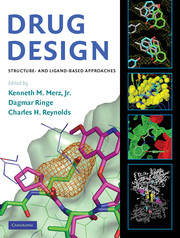Book contents
- Frontmatter
- Contents
- Contributors
- Preface
- DRUG DESIGN
- 1 Progress and issues for computationally guided lead discovery and optimization
- PART I STRUCTURAL BIOLOGY
- PART II COMPUTATIONAL CHEMISTRY METHODOLOGY
- PART III APPLICATIONS TO DRUG DISCOVERY
- 12 Computer-aided drug design: a practical guide to protein-structure-based modeling
- 13 Structure-based drug design case study: p38
- 14 Structure-based design of novel P2-P4 macrocyclic inhibitors of hepatitis C NS3/4A protease
- 15 Purine nucleoside phosphorylases as targets for transition-state analog design
- 16 GPCR 3D modeling
- 17 Structure-based design of potent glycogen phosphorylase inhibitors
- Index
- References
14 - Structure-based design of novel P2-P4 macrocyclic inhibitors of hepatitis C NS3/4A protease
from PART III - APPLICATIONS TO DRUG DISCOVERY
Published online by Cambridge University Press: 06 July 2010
- Frontmatter
- Contents
- Contributors
- Preface
- DRUG DESIGN
- 1 Progress and issues for computationally guided lead discovery and optimization
- PART I STRUCTURAL BIOLOGY
- PART II COMPUTATIONAL CHEMISTRY METHODOLOGY
- PART III APPLICATIONS TO DRUG DISCOVERY
- 12 Computer-aided drug design: a practical guide to protein-structure-based modeling
- 13 Structure-based drug design case study: p38
- 14 Structure-based design of novel P2-P4 macrocyclic inhibitors of hepatitis C NS3/4A protease
- 15 Purine nucleoside phosphorylases as targets for transition-state analog design
- 16 GPCR 3D modeling
- 17 Structure-based design of potent glycogen phosphorylase inhibitors
- Index
- References
Summary
INTRODUCTION
Approximately 170 million people worldwide are chronically infected with hepatitis C virus (HCV), a (+)-strand RNA virus of the Flaviviridae family, which is spread primarily by direct contact with human blood. HCV causes chronic liver disease, including cirrhosis and hepatocellular carcinoma. At present, HCV is a leading cause of death in HIV co-infected patients and is the most common indication for liver transplantation. In the United States alone, data from death certificates suggest that there are 10,000 to 12,000 deaths annually due to hepatitis C.
Unlike HIV, HCV can be “cured”; that is, patients can achieve a sustained virologic response (SVR), in which the virus remains undetectable after termination of therapy. The current standard of care for the most prevalent genotype 1 infection is a regimen of pegylated interferon (IFN) plus ribavirin for 48 weeks. Due to limited efficacy (only about half of genotype 1 patients are able to achieve SVR at twenty-four weeks post-therapy) and significant side effects (e.g., injection site inflammation, flu-like symptoms, depression, and anemia), many patients discontinue treatment. Thus, there is a significant need to improve efficacy, reduce the duration of treatment, and develop an IFN-free regimen with a more convenient route of administration.
DRUG DESIGN TARGET
Several promising antiviral targets for HCV have emerged in recent years. As with HIV, most efforts have focused on inhibiting the key viral enzymes (see Figure 14.1). Inhibitors of one such target, HCV NS3/4A, have perhaps shown the most dramatic antiviral effects.
- Type
- Chapter
- Information
- Drug DesignStructure- and Ligand-Based Approaches, pp. 209 - 214Publisher: Cambridge University PressPrint publication year: 2010



